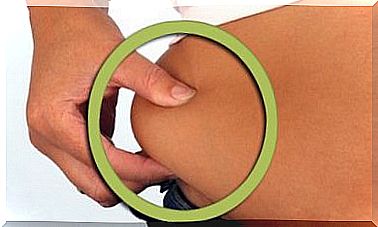Lead Poisoning: What Are The Consequences?
Lead poisoning can go unnoticed, but in some cases urgent life-threatening treatment is necessary. How do you recognize them? How is it treated?

Lead poisoning is a rare condition, but if left untreated, it can lead to serious complications. Lead is a heavy metal that has no natural function in the human body, so even a small amount is toxic to us.
In the past, lead was widely used in paint, fuels, and other products. Fortunately, research and public policies aimed at reducing consumption have proven effective. Nevertheless, there are isolated cases that arise from professional situations or living in old rooms.
The symptoms of lead poisoning are very non-specific and the main risk groups are pregnant women and young children. Do you want to know more about it? We’ll tell you all the details on the following pages.
How can lead poisoning occur?
Lead poisoning occurs when a large amount of lead is swallowed or inhaled. Until recently this was a more or less common problem as many products and fuels contained significant amounts of lead.
However, with the intervention of international organizations such as the World Health Organization (WHO), cases have gradually decreased. In particular, lead can be found in the following items and locations:
- Paint
- Old toy
- Pipes and taps
- Car batteries
- Some pieces of glass and ceramics
- Shot
- Some cosmetics
- Floors, especially those that have come into contact with gasoline or paint
Some measures to control lead poisoning cases were introduced in the United States in the late 1970s. As a result, most of the paints containing this metal had to change their manufacturing processes.
Occupational situations in which one is exposed to lead include jobs in ship repair, civil engineering, mining, plastics or battery manufacture, and plumbing.
In theory , these places should have their own preventive care systems based on an occupational health system, as accidents at work can occur in some cases.

Learn More: Carbon Monoxide Poisoning: What To Do?
Lead poisoning: symptoms in adults
Depending on the degree of poisoning, symptoms can range from very mild to life-threatening. These are quite unspecific, so that the problem is only recognized in good time in rare cases. Some patients may have the following symptoms:
- increased blood pressure
- anemia
- Head, abdominal, muscle and joint pain
- Problems with concentration and short-term memory
- weakness
- Loss of appetite
- constipation
- irritability
Often these symptoms appear insidious. As long as the cause of the poisoning (related to a work or living situation) persists, it can even worsen over time.
Symptoms in newborns
Because lead is not blocked by the placental barrier, it can interfere with the development of the fetus during pregnancy. Because many maternal lead poisoning cases go unnoticed, it can be a serious problem for babies.
Initially , this can be associated with serious birth complications. These include miscarriages, premature births, and intrauterine growth restrictions (IUGR). In rare cases, even fetal malformations can occur.
When children are born, they are most susceptible to medical complications, especially before they are five years old. In fact, there have been reports of fatal encephalopathies associated with lead poisoning.
Even if the patients are treated in good time, secondary diseases are possible. Cognitive impairment, irritability, and memory problems are some of the manifestations that typically appear over the course of life.
How is lead poisoning diagnosed?
Except in very specific professional or domestic situations, there is no explicit search for lead poisoning in hospitals. In fact, lead poisoning is unlikely to be diagnosed with very mild symptoms.
The only way to objectively diagnose the disease is through blood tests that measure the level of lead. The values depend on the laboratory in question, but since lead has only a minor function in the body, any value can already be regarded as a sign of illness.
Significant medical complications can occur above 5 µg / dL, especially in children under five years of age. Some patients may have levels of 150 µg / dL or more.
More tests
If hospitalization or additional testing is required, your healthcare provider will most likely order the following tests:
- Complete blood count (CBC) or complete hematology (CH): allows monitoring of the hemoglobin level, which can decrease in the event of chronic intoxication.
- Ecosonogram or abdomen x-ray: These tests can rule out inflammatory diseases.
- Bone marrow biopsy or aspiration: This is used to rule out other causes of anemia, especially if other parameters in the blood are changed. The results are usually normal.
- X-ray of the bones: Since lead tends to accumulate in bone tissue, this would allow an estimation of data such as exposure time and degree of poisoning. In fact, some researchers consider it one of the best diagnostic indicators this study suggests.
How is lead poisoning treated?
After the diagnosis is made, treatment will depend on the severity of symptoms and the estimated time of poisoning.
- If symptoms are mild, careful observation and oral treatment are possible. In severe cases, hospitalization and intravenous therapy are necessary.
- In the case of very noticeable acute poisoning, it is more likely that the patient will have to be admitted to the hospital. Chronic diseases can be treated more conservatively, depending on their severity.
In both cases, treatment consists of basic supportive measures and the administration of medication. The former include the administration of intravenous solutions and gastrointestinal irrigation. Medicines include chelate complexes.
The latter term refers to drugs that have the ability to bind heavy metals in the blood. This reduces their toxicity and stimulates their excretion in the urine or bile.

Lead poisoning: drug treatment
So far there are four drugs for cases of lead poisoning. Not all of them are approved worldwide, as there are different regulations in different countries.
- Calcium edetate disodium: also known as EDTA, is administered intravenously and usually in cycles
- Dimercaprol: This drug can be given intramuscularly
- Penicillamine: This is used for long-term oral treatment so it can also be used on an outpatient basis
- Succimer: is also used orally
All of these options require a medical indication. Depending on individual patient characteristics, complications such as hepatitis, liver failure, and allergic reactions can occur.
Lead poisoning: prevention
The most common source of lead poisoning today is contact with old products and the work environment. The first case concerns paint that was marketed prior to international lead regulations in industrial environments.
If contact with lead is likely, it is important to note the following:
- Wash surfaces that may be contaminated
- Washing hands before and after eating, especially with children
- When doing repairs in old houses, do not sand the surface by hand and without protection
- A healthy and balanced diet
- Consume only drinking water that has been properly filtered and purified.
- If you deal with junk regularly, don’t put it in your mouth.
If you have symptoms that apply to lead poisoning, see a doctor as soon as possible. If the symptoms are mild, it is possible to schedule an appointment early. In moderate or severe cases, however, you should go to the emergency room immediately.
Final recommendations for lead poisoning
Although lead poisoning is a rare condition, it is necessary to see a doctor if symptoms occur. This is especially important in high-risk groups, such as pregnant women and young children. Even low concentrations can cause permanent damage.
Which specialist should it be?
Most medical specialists who provide full care to the patient can diagnose lead poisoning. That is why going to the family doctor, internist or pediatrician is the first step. If you need an assessment from another specialist, they will guide you through the entire procedure.
Lead Poisoning: How To Prepare For A Consultation?
Once you’ve scheduled a doctor’s appointment, try to follow these recommendations as best you can:
- Think about how long you’ve been suffering from the symptoms and what medications you took to relieve the symptoms.
- If you have a pre-existing condition, let your doctor know about it at the beginning. This of course also includes chronic diseases and allergies.
- If you have the latest laboratory tests, bring them with you to the appointment, regardless of the format.
- Are you taking any medication? Bring this with you to the appointment or write the name down on a piece of paper. If you do need to take medication, there are some interactions for your doctor to consider.
- Try to identify a specific cause of the lead poisoning. The most common situations are listed above.
- Bring a second person. Sometimes fear can prevent you from clearly remembering the doctor’s recommendations.
Immediate intervention in case of lead poisoning is crucial for the prognosis and the course. Therefore, if you suspect lead poisoning, you should consult a doctor immediately. Note this!









